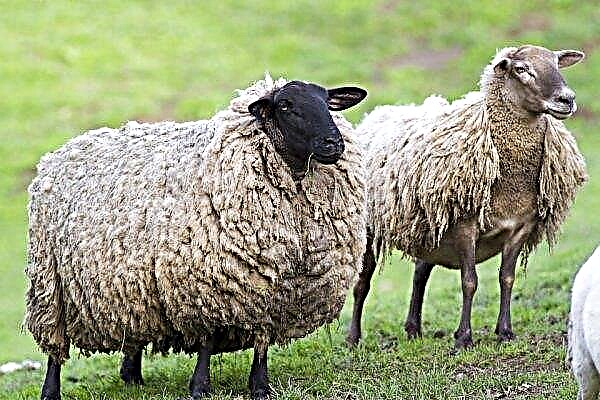Each poultry breeder should be able to determine the gender of the hatched chickens. This skill is necessary so that when buying or raising young animals, one should not be mistaken in choosing the very bird that meets his needs. In the article we will tell you how to find out who develops in the testicle - a rooster or a chicken, and also to distinguish the gender of the chicks after their birth.
How to determine the gender of the chicken
Newborn chicks in daily age are almost no different from each other. Experienced poultry farmers are well versed in their gender differences, but beginners must learn this. There are several proven methods for determining which chicken is a boy and which is a girl in the first 2 weeks after birth.
By breed
Some breeds of chickens (autosex) facilitate the task of kurovods, as their heterosexual chicks have specific distinguishing features.
Important! Practice shows that not one common method gives a full guarantee of the exact sex determination of chicks. Therefore, in this case, it is advisable to apply several tests at once.
Leghorn and Legbar
Hens and males of such breeds differ from each other in the following characteristic features:
- diurnal females have fluff dyed in an even tone (gray, white or black);
- diurnal males have characteristic stripes.

Brahma
Brahma chickens differ in the following ways:
- hens are decorated on the body with clearly visible stripes and dots on the heads;
- males have a blurry, rippled color.

Rhode Island, New Hampshire
Newborn chicks of these breeds have the following sex differences:
- females have dark stripes and blotches on temechki;
- males are born with a uniform yellow color.

Adler silver
The daily chicks of the Adler breed of chickens are painted as follows:
- females are bright yellow;
- males - light lemon color, with a bright dark strip on the tops.

To size
It is believed that among chickens of any breed, boys are always larger than girls.
This can be seen from the following:
- the legs of young roosters are more massive and wider;
- the baby’s body itself is taller and more voluminous;
- the head is larger and rounder;
- weight 1-2 g more.
Despite these differences, the test for determining the sex of chicks by size cannot be considered accurate, since the development of each individual is individual. Also, within a single breed, a chicken by weight can be slightly heavier than its brother.
Did you know? US geneticists have developed a method for determining the sex of a chicken still in the egg called EggXYt. This technology involves implanting a genetic marker in the hen, which then, when scanned, appears only on the future cockerel.
By feathers and wings
The most common method for determining the difference between a rooster and a chicken is by plumage on wings and body:
- the chicken is able to lean much earlier than the cockerel;
- in the female, the wing feathers on the wings are rare and different in size and length;
- the cockerel has larger wingspan, with larger and more frequent feathers;
- two-week-old hens already have well-grown tail feathers, while in males the tails grow more slowly;
- the males slowly change the down layer, and in the female, the body is actively covered with fluff for 21 days.
How to determine the gender of the chicken: video
By color
In addition to the color distinguishing features of autosex breeds, to determine the sex of chicks by color, it is important to know some of the nuances of the cross features: when the rooster has brown plumage and the chicken is white, the downy color will be transmitted to the newborn chicks by the cross method.
This implies:
- girls will inherit a fluff of golden brown color (on the paternal side);
- in boys, the fluff will be painted in yellow-silver tones (according to the signs of the maternal color).
In the egg
There are several ways to test for sexual differences in future chicks at the stage of their formation in the egg:
- Examining the shape of the testicle. A more round one will tell about the formation of a female in it, and a sharp one with an elongated end will tell about the appearance of a cockerel.
- According to the structure of the shell on the acute side of the egg. A smooth shell indicates the future birth of the female; eggs with tubercles and hills can contain inside males.
- With an ovoscope. When illuminating an egg, you need to find the location of the air chamber (usually from the blunt end): when it is located in the center, we should expect the appearance of a cockerel; a shift to any side from the center indicates the future birth of a laying hen.
Important! Determining the sex of the future chicken by the eggshell can show accuracy only if the eggs are laid by one laying hen.
Walking
You can distinguish chickens on the floor by gait and the shape of their legs:
- boys have wider metatarsuses, fleshy and long legs; their gait has a wide gait, they move, as if marching;
- girls are distinguished by raising and lowering their legs in a rhythmic gait, with a buildup; their legs are shorter.

Reflex method
Another proven way to determine the sex of the chicken is by reflexes, because in the same situation the male and female will behave differently.
To do this, you can do several of the following manipulations:
- Carefully take the chick by the scruff of the neck - the male will lower its legs, extend its neck and will look around with curiosity; the female will retract the neck, press the legs to her tummy and close her eyes.
- To create a small noise effect near a box with young animals, for example, clap their hands slightly (we emphasize that the use of this method can cause stress in chickens, and this negatively affects their immunity) - in case of fright, the females will sit on the floor of the box, pulling their necks in; males “in a manly way” will prepare to protect the family: they will stretch their necks, raise their heads and squeak.
- Carefully grab the chick by its legs and gently turn it upside down - the cock will spread its wings right there, as if preparing to fly; pieces will be grouped and try to pull the body to the legs.
Japanese way
Japanese chisels use another method of checking the sex of chicks - the study of their genitals. The described method requires skill, because these organs are inside the body of chickens: the testes of the cockerels are located in the cesspool.
Sexual manipulation is done very carefully, in the first 6 hours after the birth of the birds. After a 7-hour period, the cock penis is closed with a skin fold, after which it will not be possible to determine the sex using this method.Examine the genitals of chickens in the following sequence:
- you need to completely grip the chicken with your palm and gently turn the head down, fixing its paws between the index and middle fingers;
- gently press on the bottom of the tummy, helping the cesspool to turn slightly out;
- inspect the hole - the chicken has a smooth cesspool with a smooth edge; the cockerel will see a genital tubercle.
Did you know? A chicken is able to recognize an egg with a dead embryo in the clutch, after which it will push it out of the total mass to the edge of the nest.
Gender Determination Methods for Teen Chicks
Determination of gender differences in the younger generation of chicken livestock is not difficult.
3-4 weeks of life
Chicks at the age of one month already differ visually:
- hens are actively overgrown with plumage; they are smaller than cocks;
- boys run only slightly downy; per month they are much larger than girls.

At 6–10 weeks of life
By 2-3 months of life, chickens can be easily distinguished by gender.
Males are characterized by such features:
- they are larger than hens;
- a pronounced red scallop forms;
- catkins and beard grow;
- longer braids begin to grow in the tail;
- the muzzle is rounded, acquires a reddish tint;
- the legs are lengthened, spurs grow on them.
Chickens have the following symptoms:
- in size they are smaller than males;
- have shorter and erect tails;
- small and neat scallop has a pale color;
- on thinner legs there are practically no spurs;
- there is a good plumage.
As you can see, the sex of the chicken is not so difficult to determine if you use one or more of the methods presented in the article. Although some of them do not give one hundred percent accuracy, an experienced poultry breeder will still be able to assess with their help the sex of his feathered young.












